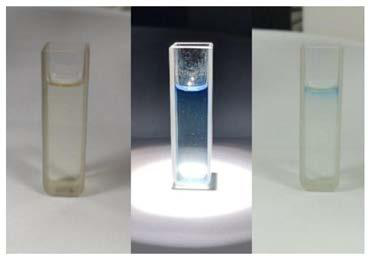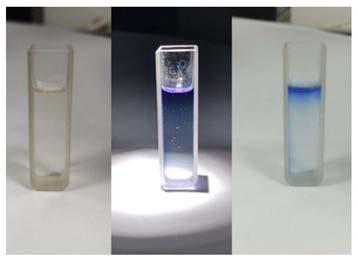Indeno-condensed naphtho-spirooxazine photochromic compound and preparation method thereof
A naphthospiroxazine, photochromic technology, applied in chemical instruments and methods, color-changing fluorescent materials, organic chemistry, etc., can solve the problems of low photoreaction conversion efficiency, and achieve rapid photoresponse, fast fading, and fatigue resistance. good effect
- Summary
- Abstract
- Description
- Claims
- Application Information
AI Technical Summary
Problems solved by technology
Method used
Image
Examples
Embodiment 1
[0033] The preparation of embodiment 1 photochromic compound Ia
[0034] The first step: Synthesis of 7,7-dimethyl-5-nitroso-7H-benzo[c]fluoren-6-ol
[0035]
[0036] Add 7,7-dihydrocarbyl-7H-benzo[c]fluoren-6-ol (0.41g, 1.6mmol), 20mL of acetonitrile, 20mL of water and 3mL of sodium hydroxide (2%) into a round-bottomed flask, ice-bathed , stir. A small amount of sodium nitrite (0.11 g, 1.65 mmol) was added as a solid, and the reaction was stirred for 1 hour at 0-5°C. 0.38 mL of dilute sulfuric acid solution (5.6 M) was added to the reaction liquid, and the reaction was continued for 1 hour. Suction filtration, the filter cake was washed twice with a small amount of water, and dried. The crude product was purified by silica gel column chromatography using a mixture of petroleum ether: ethyl acetate = 30:1 by volume as the eluent to obtain 0.36 g of an orange-red solid product with a yield of 78%.
[0037] The characterization data of 7,7-dihydrocarbyl-7H-benzo[c]fluoren...
Embodiment 2
[0044] The preparation of embodiment 2 photochromic compound Ib, reaction formula is as follows:
[0045]
[0046] Add 0.29 g (1.00 mmol) of 7,7-dimethyl-5-nitroso-7H-benzo[c]fluoren-6-ol and 30 mL of ethanol into the reaction flask, stir to dissolve, and heat to 90°C. N 2 For protection, slowly dropwise add 5-mL ethanol solution containing 0.25 g (1.20 mmol) of 5-chloro-1,3,3-trimethyl-2-methyleneindoline, and react under reflux for 24 hours. After cooling to room temperature, the reaction solution was concentrated under reduced pressure to remove the solvent. The residue was purified by silica gel column chromatography using a mixture of petroleum ether: ethyl acetate = 200:1 by volume as the eluent to obtain 80 mg of a brown oily product with a yield of 17%.
[0047] The proton nuclear magnetic resonance spectrum characterization data of 1b is: 1 H NMR (400MHz, CDCl 3 )δ8.71(d, J=8.0Hz, 2H), 8.32(d, J=8.0Hz, 1H), 7.82(s, 1H), 7.64–7.60(m, 1H), 7.57–7.53(m, 1H ),7.42...
Embodiment 3
[0049] The preparation of embodiment 3 photochromic compound Ic, reaction formula is as follows:
[0050]
[0051] Add 0.15 g (0.52 mmol) of 7,7-dimethyl-5-nitroso-7H-benzo[c]fluoren-6-ol and 20 mL of ethanol obtained in the previous step into the reaction flask, stir to dissolve, and heat to 90 ℃. N 2 For protection, a 5 mL ethanol solution containing 1,3,3-trimethyl-2-methyleneindoline 111 mg (0.62 mmol) was slowly added dropwise, and the reaction was refluxed for 24 hours. After cooling to room temperature, the reaction solution was concentrated under reduced pressure to remove the solvent. The residue was purified by silica gel column chromatography using a mixture of petroleum ether: ethyl acetate = 200:1 by volume as the eluent to obtain 70 mg of a brown oily product with a yield of 30%.
[0052] The H NMR spectrum characterization data of Ic are: 1 H NMR (400MHz, CDCl 3 )δ8.74(d, J=8.0Hz, 1H), 8.70(d, J=8.0Hz, 1H), 8.31(d, J=8.0Hz, 1H), 7.84(s, 1H), 7.63–7.59( ...
PUM
 Login to View More
Login to View More Abstract
Description
Claims
Application Information
 Login to View More
Login to View More - R&D
- Intellectual Property
- Life Sciences
- Materials
- Tech Scout
- Unparalleled Data Quality
- Higher Quality Content
- 60% Fewer Hallucinations
Browse by: Latest US Patents, China's latest patents, Technical Efficacy Thesaurus, Application Domain, Technology Topic, Popular Technical Reports.
© 2025 PatSnap. All rights reserved.Legal|Privacy policy|Modern Slavery Act Transparency Statement|Sitemap|About US| Contact US: help@patsnap.com



